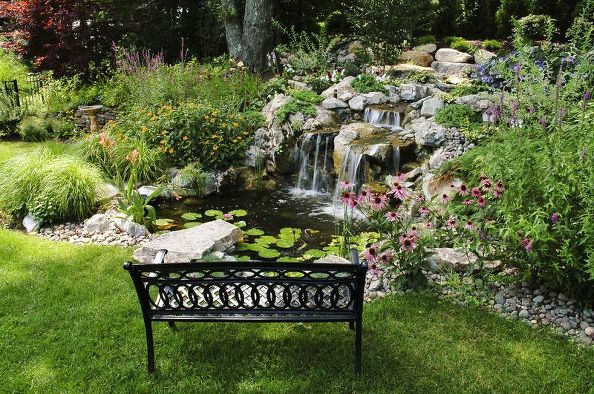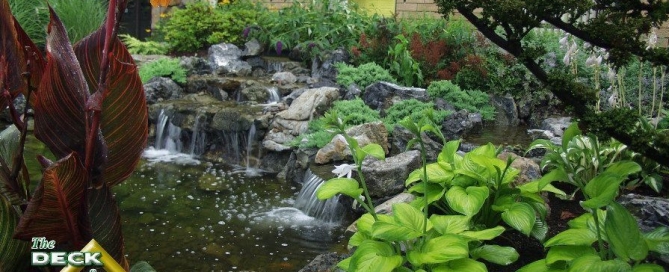Key Elements of a Healthy, Low-Maintenance Pond
A low-maintenance pond is one with an ecosystem that works naturally with Mother Nature to keep the pond clean and clear. It is a paradise for families to relax by and study throughout all seasons. It also offers a healthy place for desirable wildlife, such as pond fish, birds, etc.
Such a delightful backyard feature has several elements that contribute to its overall harmony. As certified Aquascape Inc. contractors, Deck and Patio keeps regularly up-to-date with the latest in pond design, construction and maintenance.
Proper Water Circulation
It is essential that any water pump be adequate to the size of your pond and waterfalls. This ensures the amount of water will be aerated sufficiently and will not stagnate or develop excessive bacteria. Instead, the pond receives adequate oxygenation to remain healthy.
Biological Filters and Skimmers
Ponds should also include a natural filtration system using the right biological filter and mechanical skimmer. Adding rocks and gravel over pond liners will also allow beneficial bacteria to grow for fish to graze on.
Pond Fish
Koi, in all their jeweled colors, are not just beautiful to look at. They eat algae, and their own waste turns into fertilizer for pond plants. It’s key, though, not to overstock your pond so the balance of fish waste, verses what is being used up, remains in proper balance.
Aquatic Plants
And you thought plants, too, were just pretty faces. No, they also play a key role in filtering a pond’s ecosystem. Aquatic plants absorb nutrients from the fish waste. “In the heat of summer, for example, it’s ideal that approximately 40% of your pond’s surface be covered with plants. Not only do they take care of the algae they also provide shade for the fish when it’s hot,” says Dave Stockwell of Deck and Patio.
“A backyard pond should be a paradise for relaxation as well as a home for desirable wildlife,” adds Dave Stockwell. “I’m referring to wildlife such as birds, frogs, etc. who eat insects as they enjoy the shelter you’ve created for them. In addition, aquatic plants and pond fish are essential elements in the overall ecosystem.”
Sometimes, Deck and Patio clients want to go even further when creating a natural healthy pond ecosystem. “That’s the rainwater harvesting comes into play,” says Dave. “This involves capturing rainwater, filtering it, and trapping it below ground to be recirculated to maintain the pond’s water level because of evaporation. Aquascape Inc. of St. Charles, IL, has superb systems that capture and circulate rainwater.”
This captured water never stagnates, says Brian Helfrich, construction manager at Aquascape, because the water is continuously circulated in the pond via a waterfall, or stream, or pond fountain.
“Rainfall shortages will never be a problem,” says Helfrich. “Plus, with such a system, town or city water is never being used. Those with an underground storage tank — stocked with water they may have collected a month ago, even during a drought, will not only keep their water feature fresh and moving, but excess water reserves can maintain a lawn, and/or a vegetable garden.”
This beautiful award-winning water feature (silver medal from LIPSA) consists of a stream, waterfalls and pond; it’s the perfect spot for letting the day’s cares melt away. Enchanting Echinacea (coneflowers) and magenta Lythrum are some of the plants brightening this pondscape.
Water is the basis of all successful ecosystems. The second you put in a water feature you attract all kinds of wildlife — birds who want to bathe, frogs, salamanders, and insects that the birds feed on.
Contrary to popular belief, fish will actually reduce pond maintenance, as they graze on string algae and bottom feed from the pond floor. Plants shown here include bullrush, pink canna lilies, horsetail, and a rose arey hybrid water lily.
“A healthy pond does require some spring and fall maintenance,” says Dave Stockwell. “However, if you build your pond correctly, Mother Nature will do the rest. Not only will you love it in every season, but frogs, birds and butterflies will thank you for it.”

















